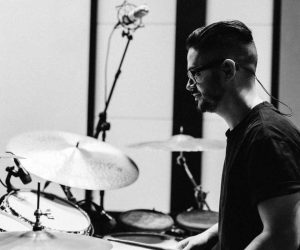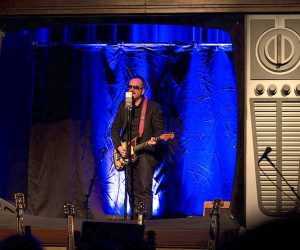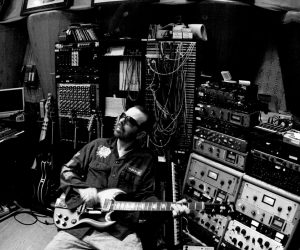
Fresh Produce: Katy Steele’s ‘Big Star’
The highs and lows of self-production, according to Katy Steele and Graham McLuskie.

Album: Big Star
Artist: Katy Steele
Katy Steele and her partner Graham McLuskie shared an experience that solidified their passion for music production while working on Katy’s second solo album ‘Big Star’, but it was not without a steep learning curve. This fearless first attempt saw them set up a home studio and then unabashedly learn on-the-job as they wrote and produced an album — a process that arched across five years.
From a lifestyle perspective, having a home studio can give the freedom to work at one’s own pace — especially desirable with two young children in tow — and having no firm deadlines can mean more time to experiment with ideas. On paper this may seem beneficial but, as the duo quickly found, with freedom comes responsibility.
Prior to this, Katy’s 2016 breakaway album ‘Human’ was an electronica-tinged side-step from her previous work with indie-pop outfit Little Birdie. It was also a much darker vessel, and offered a kind of sneak-peak of things to come. But compared to the reflective mood of ‘Human’, 2023’s ‘Big Star’ presents the audience with a bold, fresh new sound, with a more resolved feel.
START YOUR ENGINEERS
The album’s vaporwave opener, ‘Come And See Me’, sets the album’s warm, buzzy tone, with Katy’s iconic voice positioned front and centre, but this wasn’t always the intention. “In my head I thought it was going to be a stripped back solo record, with me and a guitar, and maybe some choir,” stated Katy. “The shift from there was pretty natural — first with the home setup, and then having Graham’s influences coming through.”
Behind the album’s upfront dynamic is an ear-wormfarm loaded with hooks, bass-line variations, and tight instrumentation. It’s the sum of all these aspects that make it surprising to discover that neither Katy nor Graham have much of a background in audio production. “Graham hadn’t produced anything before. It actually reminded me of when I first started to write songs, when I only knew three chords. It’s nice that we both started in a similar way, being able to get into music with that kind of naivety,” continued Katy.
The project was a slow-burner with its roots planted in pre-Covid times, where several song sketches were penned after an extended trip to visit Graham’s family in Scotland. “We ended up buying a bunch of gear there. We bought a pair of Genelec monitors, an AKG mic, and a couple of other bits and pieces, and just started tinkering away,” said Graham. “Katy doesn’t like to admit it, but we started writing this album back then, in about 2018. That was when the first two or three tracks started coming together. It’s taken us all that time to understand how things work, and to grasp the process of recording.”
KEY TO A LOCKDOWN
There are many reasons to lean towards self-production — budgets or an aesthetic preference, for example — but Katy and Graham’s choice was made for them. Shortly after returning from overseas the world became a very different place. According to Katy, “Things on this project really started to happen during Covid because we couldn’t go anywhere, and we couldn’t plan anything.” So with new songs rattling around, and armed with their new equipment, they decided to see how far they could get on their own.
Keyboards and synthesisers were among the gear acquired in Scotland, and the lockdown restrictions meant that these instruments would become foundational elements, influencing the shape and sound of the album. Starting out with a narrow selection of instruments turned out to be a blessing in disguise. Creating song-beds with a restricted palette meant that a certain coherence was being unconsciously written into the skeleton of the album. “We bought a Roland Juno 6, an old Casio CT-401, and a Korg SV-2 over there as well,” said Katy. “The Korg SV-2 actually has a great Yamaha CP-80 piano kind of vibe, and once we found a few of these sounds we started using them on every song.”
Katy’s voice was also a thread of continuity through the varied approaches of the album, but consolidating an album of songs that require different production techniques can still pose a challenge. Graham explained: “Back when I was first learning how to produce, a lot of the songs were sounding very different to each other. It took me about two years to really find my feet, as well as a couple of years to dial in on a ‘sound’. And to then be able to replicate that across the record.”

Most of it was recorded in the bedroom with a Neumann U87. I worked completely in-the-box, so was mainly using UAD’s collection of plugins — generally using the 1176, LA-2A, or 1073 at the start of the chain, and then sometimes adding a bit of EQ at the other end
A CASUAL ARRANGEMENT
Given that Katy’s voice is the album’s centrepiece, how did the pair tackle the task of capturing, treating, and mixing it? After landing on an overall desired vocal sound, they began looking at how best to present the essence of these parts. Some of this essence was in the effortless, off-the-cuff nature of the guide-tracks. Katy explained how these early takes would influence the song’s development, and often end up as part of the song. She said, “As we began to track vocal demos we’d usually set out thinking, ‘Oh, it’s only a demo, it’s just rough’ — not taking much care with them. We found that this would result in something that felt more spontaneous, and sounded really great. In fact, we wound up using the original demos on ‘LMK’ because they had a kind of quality that we just couldn’t replicate.”
Vocals were recorded at home in their DIY studio which was a flexible, dual purpose space: the spare bedroom. The setup was minimal but effective, and allowed them to work whenever the mood took them. “We had a really good home setup, and it sounded amazing,” recollected Graham. “Most of it was recorded in the bedroom with a Neumann U87. I worked completely in-the-box, so was mainly using UAD’s collection of plugins — generally using the 1176, LA-2A, or 1073 at the start of the chain, and then sometimes adding a bit of EQ at the other end.” He continued, “I did start experimenting with other plugins too — the Manley VoxBox and Avalon VT-737 both worked really well with Katy’s vocals — but her voice was so consistent that I didn’t need to go too hard on that side of things.”
SIGNATURE VOCAL SOUND
The key to Katy’s signature sound was less about plugins and more to do with layering her vocal parts, relying more on doubling and panning to highlight her unique delivery. When replicated in unison, the precision of Katy’s performances results in a gently chorussing movement. Katy commented that she’s also a fan of adding harmonies to create lush vocal beds. “I always double up my vocals, but I love harmonising too. They come to me quite naturally, so we end up having lots to play around with.”
But Graham, who proves to be the patient one, quickly added, “There were sometimes triple and quadruple vocal parts — and then there were the harmonies. We took the songs to a certain point — kind of throwing everything at the wall, so to speak — and then had to scale it all back again to restrain the pallete. I mean, it’s great to have so many vocals to work with, don’t get me wrong, but it was also quite a process to thin them all out.”
With all of the vocal comping now out of the way, both Katy’s main and backing parts have been left relatively intact, only receiving subtle processing to help with focus and placement in the stereo field. “We did use Arturia’s Dimension D chorus and UberMod from Valhalla, and the Eventide H910 plugin,” recalled Graham. “And down the track, when we had a remix of ‘Come See Me’ done in a studio in Perth, they put Katy’s vocals through a physical H3000 unit.” Katy also noted that “We tried the Antares Harmony Engine as well. I didn’t really like what it came up with but Graham definitely vibed on it.”
Through all of this trial and error, the pair refined their process and ended up with a solid approach that allowed them to confidently capture and process vocal takes. More importantly, being a simple home setup meant that they could leave it partially set up. “Now we can have things waiting, ready for an inspired moment from Katy,” said Graham. “And we know we can get something sounding good, straight off the bat. We just need a good mic and preamp. And a good vocalist!”
TRADE TOOLS
As far as instrumentation went, most of it was performed by Katy and Graham on the collection of instruments they’d picked up overseas. “The Juno was doing arpeggiated bass and leads on ‘Feel So Bad’ and ‘Come And See Me’, but unfortunately we’ve just sold that,” shared Graham. “And ‘End Is Near’ has Katy’s SV-2 parts all over it.”
So, in addition to the the Roland Juno 6 and Korg SV-2 hardware synths — and the Casio keyboard — a couple of software options were employed too. These included: Reverb Machine’s RM-20, the virtual instrument that samples sounds from the Yamaha PS-20; the Arturia CMI-V plugin emulation of the Fairlight digital sampler and synthesiser; and the U-He Diva soft synth that models the components and modules of a handful of vintage analogue synthesisers.
Graham gave some further detail: “I was watching a lot of ‘Mix With The Masters’ at the time, which I was finding really inspirational. There was one in particular with Illangelo, and while I’m not a massive fan of the music, his process really resonated with the way Katy and I were approaching the record. I spotted that he was using the Diva in the video so we gave it a shot and ended up using it quite a bit. ‘Feel So Bad’ had a lot of that on it.” He continued, “‘Beside that one, there was also a preset from the Arturia CMI-V plugin that we used on ‘Falling Apart’.”
Katy chimed in, saying, “The Casiotone, the SV-2, and the CMI-V plugin patch all created such a canvas across the album. We also dug our old Casiotone 401, but then found the RM-20 plugin which is essentially the Beach House sound.”
We just need a good mic and preamp. And a good vocalist!

HIRED TUNES
When working on an album by yourself, having only a single creative source can create a homogenous outcome, so while Katy and Graham were the core songwriters and performers, they also enlisted the talent of a few others. These additions contributed different perspectives to the process, which helped to broaden their sound.
Local Perth multi-instrumentalist, Josiah Padmanabham, made an appearance, and ended up playing quite a significant role across the record. Graham explained: “It was a really interesting process. Josiah was such a gun, and really brought a different colour to things. When he sat down in front of a synth you’d have to hit record straight away because he’d do something magical and you’d never get him to recreate it.” Katy also added, “We added a couple of backing singers too — Tara and Solomon came and helped out. They were recorded at Poons Head Studios in Fremantle, and you’ll no doubt hear them throughout the album.”

MIX & MATCH
Of the three mix engineers auditioned to work on the mixdown, Dave Hammer was the one they selected to carry out the final duties. But besides being hired to give the album a general spruce up, and a tying up of loose-ends, he also ended up making some creative decisions that helped reduce the clutter of mixes and sessions. So, after working intimately on something for so long, how did Katy and Graham feel about passing that kind of control on to an outsider?
Katy remarked: “We were still kind of working things out when we got Dave on board, but he really elevated the album. Graham had produced and mixed pretty much all the songs, but then Dave took it all up a notch in his final pass. He was also very patient with us.” Graham continued, saying, “Dave did the final mixes on the majority of the album, but he helped us to strip things back a bit too. We’d send him our sessions, and some of those were pretty big — sometimes with 80-100 tracks… But he came in with fresh ears and a different approach and made such a difference. I knew this all needed to happen, but I wasn’t the right person to do it because I was too attached. So Dave helped us by making things more manageable — but I’m sure he could have gotten rid of a bunch of other stuff without us noticing too!”

LIVE WIRES
Katy and Graham settled on Ableton as their DAW of choice (via Logic and Luna) which proved a good choice when it came time to prep for live performances. And speaking of which, what does their live contingent look like? Well, Katy has been so inspired by the performances that the Korg SV-2 and its RH3 keybed is joining them on tour. Straight to the pool room. She explained that, “The SV-2 has really changed everything — it’s just so beautiful to play… It’s changed how I write and perform, so it’s replacing my Nord on tour. Those old Nord keys feel so flimsy now, but the Korg’s keys are weighted so it plays just like a real piano.” And compared to the Nord, the Korg probably feels like it weighs as much as one too.
But the Korg has played a creative role in more ways than one. Given this preference for it over the Nord, the comparatively smaller library of sounds in the Korg means they’ve had to be more particular about choices in the studio to ensure the sound can be replicated live on stage. Graham shares, “It sounds great straight out the box, you know? It’s not got as many sounds as the Nord which means we have to be more conscious of what we’re adding to songs to ensure the Korg’s live patches can translate them — but it has such a nice feel to it, so it’s all worth it.”
With a 14-date national tour lined up, tour preparations began. Graham offered some insights on this, and stated that, “We had Josiah playing in the band in the studio, but we’ll be stripping it back for the live shows, with just Katy and I performing. A lot of the synths will be on backing tracks, but I’ll be playing some live synth and guitar too. And because we’ve had Ableton running in the studio we’ll be able to transition to our live performances easily.” Katy will be also juggling some roles on tour, and said, “I’ll be playing acoustic and electric guitar, and keyboard. And obviously some singing!”
The pair are stepping it up a notch on stage in other departments too. Katy goes on to say, “Graham is currently doing a tech rehearsal because we’ve just hooked up our new in-ear monitoring rig. Everything will be running through a Behringer x32 Rack so that we can have more consistency from venue to venue.”

THE VIEW FROM HER
Considering Katy’s history in the music industry, it’s interesting to imagine how she might have found this experience compared to her previous album-making endeavours. This one has been different on a few levels: with a new addition to her repertoire being the straddling of parental commitments while being a musician; and then more widely, that there’s been so much social and musical change in the world in the last 20 years. Katy says it’s been an interesting journey, stating, “I’ve kind of taken it all in my stride — being a mother to a 14 month old and 5 year old means that life’s hectic. Time is just so precious to us, so that’s been really hard. And the industry is just so completely different now, it’s kind of an upside-down world. I mean, Kanye West puts out a record, then decides to change the mix after it had been released — he just took it down and changed the files, you know? Crazy.” Katy said that as part of that, she and Graham often discuss the importance of being independent, and not taking that for granted. “It’s amazing to realise that now we can do what we want, because we just can.”
With ‘abundance of choice’ being an underlying theme of this album’s story, and without deadlines in place, the creative luxury of working from a home studio quickly became a hindrance. Having no time constraints made it harder to finalise ideas — and easier to get bogged down in the extra choices that were needing to be made. In regard to having such fluid goal posts, Katy said: “It kept ballooning and getting more adventurous. The finished product is the result of a lot of work, and a lot of experimentation — a lot of hours, a lot of sleepless nights… And sleepless days!”
As the album project wound down there was some reflection on the journey. With confidence built, lessons learned, and new skills developed, Graham shares his thoughts on the final outcome by saying: “There’s definitely lots of things we’d do differently next time, 100 percent. It was pretty stressful towards the end, for sure.” Katy wrapped up by saying, “I’m really proud of what we’ve achieved. I can’t wait to do the next one, and see where we end up. It feels like we’ve just started, and this is just the beginning.”
























Great article will definately give the album a listen